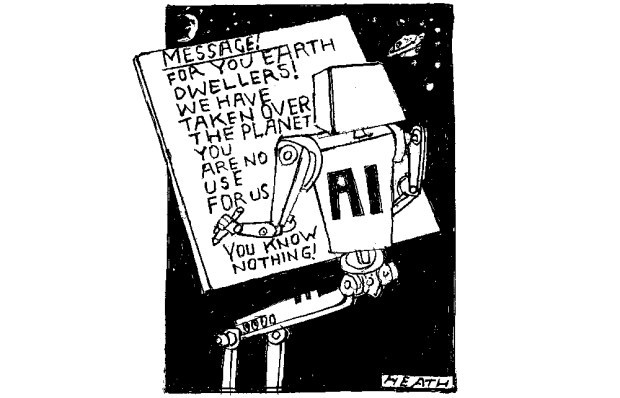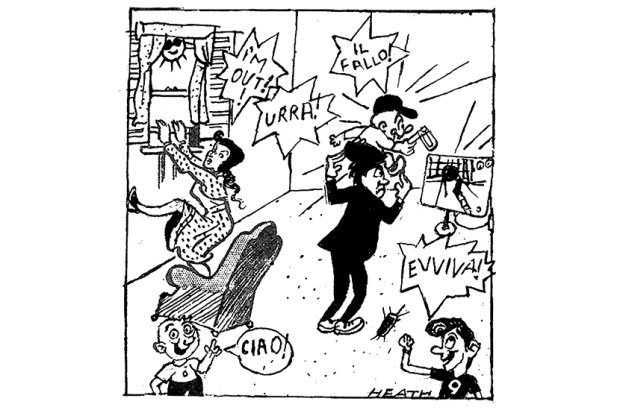Almost all of Venice’s greatest treasures are on public view. Anyone who visits can look across from the Doge’s Palace to the island of San Giorgio Maggiore, or take the vaporetto to see Palladio’s astonishing church. But it’s harder to sneak inside the doors of the monastery in San Giorgio, one of the city’s 118 islands. It is now home to Fondazione Giorgio Cini, a cultural institution and retreat sufficiently magnificent and isolated to have hosted the G7 meetings of 1980 and 1987. Last week it hosted the Alpine Fellowship, a gathering of philosophers, artists, writers and musicians. This year tackled the question of self-expression in the age of instant communication. A millennium-old monastery is the perfect place to consider what’s going right, and wrong.
Many of the speakers identified one of the plagues of the digital age: selfie-stick-wielding tourists who swarm Venice like the mosquitos in August. As Roger Scruton put it, ‘That the selfie-taker in Piazza San Marco regards herself as so important that Venice should be in the mere background of her image is the sort of intelligent judgment that the selfie-taker cannot cope with.’ The smartphone camera is the root cause, Scruton argued, in that the selfie has become the modern form of self-portrait without criticism. In using the pen, we are conscious of an instrument that has been used — and practised by great writers — through the ages. Not so with the camera smartphone.
Who to blame? Facebook, Instagram, Snapchat — and the other websites who make so much money from the boom in digital narcissism. As someone who spends time with the founders of technology companies, I was there partly to defend the twentysomethings of Silicon Valley. If things look bad now, I argued, just imagine ten years hence. Facebook’s founder laid down what is known as Zuckerberg’s Law, which is that every year, people will share twice as much personal information as the previous year. Today, we share 500 times as much as we did in 2005, Facebook’s second year. But by 2025, we will be sharing 500,000 times as much personal information. And if you think we’ll run out of things to share, ask yourself: did you imagine ten years ago that people would post their pulse rate or their jogging speed on Facebook? That they’d find a way to tell their digital ‘friends’ every time they put on a record? And that their friends would find this interesting?
To Scruton, this is all evidence that the youth of today are experiencing life at a remove, rather than in the present. Life is ephemeral, but the youth of today does not believe an event happened if it is not recorded for posterity. No less an authority than Glamour magazine was invoked to illustrate that ‘the average 16- to 25-year-old woman spends five hours a week taking selfies’, but how does one explain the rise of Snapchat, which has ephemerality at its core? Robert Burns may seem unlikely as poet laureate for the Silicon Valley generation, but Snapchat’s founder, Evan Spiegel, recently made the case that the need for the selfie rests with the human desire to which Burns gave voice: ‘And would some Power the gift give us/ to see ourselves as others see us.’
Not so long ago, the opposite trend gripped Venice: its citizens wore masks for six months of the year. The cultural historian Jim Johnson has spent years (including time in the libraries of Fondazione Giorgio Cini) researching the role of the mask, which was popular from the late 1600s through to the state’s demise in 1797. Perhaps most remarkably, foreign ambassadors were expected to wear masks when meeting Venetian patricians; such conversations were forbidden, so the mask provided a level of plausible deniability. The French ambassador to the court of mid-18th-century Venice reported back to Louis XV on exchanges he had with the Doge which, thanks to the mask, could be of ‘sincerest testimony’.
Had Hillary Clinton followed these tried and tested principles in her stint as the United States’s top diplomat, her presidential campaign might not be in the trouble in which it now finds itself. Some 10,000 pages of her emails have now been released, and her enemies are trawling every word. She now looks highly beatable, whether by Joe Biden in the primaries or one of the saner Republicans (John Kasich or Marco Rubio) in next year’s election. With her email server now in the possession of the FBI, we’ll soon see whether those deleted ‘personal’ emails are really irrecoverable. It is unlikely, given the way of modern communications. Just look at Spiegel. At Snapchat, he’s been the pioneer of disappearing messages, yet was still a victim of his private email exchanges being made public in the Sony hack. The word ‘delete’ is misleading: it really means ‘hide, until such times as this may incriminate’. We’re living not just in the age of instant communication, but of the digital downfall. So there is a gap in the market for a tool ensuring safe, effective communication. What about the pen?
Got something to add? Join the discussion and comment below.
Get 10 issues for just $10
Subscribe to The Spectator Australia today for the next 10 magazine issues, plus full online access, for just $10.
You might disagree with half of it, but you’ll enjoy reading all of it. Try your first month for free, then just $2 a week for the remainder of your first year.














Comments
Don't miss out
Join the conversation with other Spectator Australia readers. Subscribe to leave a comment.
SUBSCRIBEAlready a subscriber? Log in